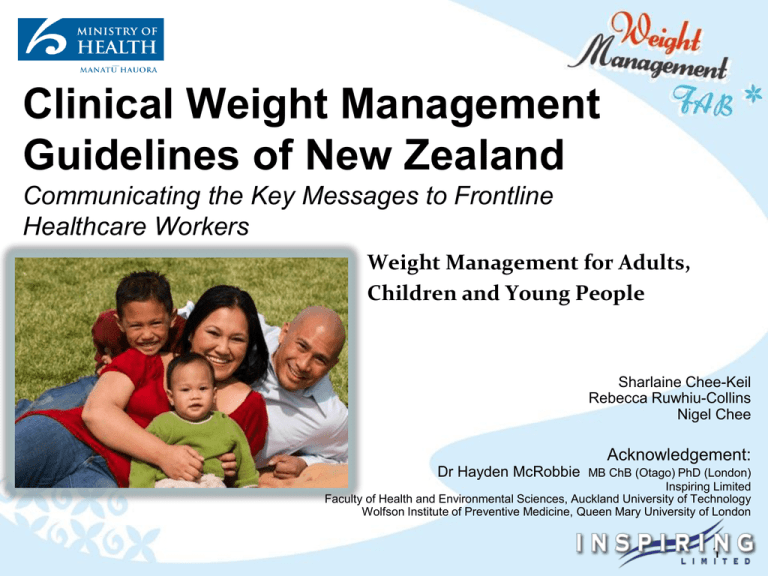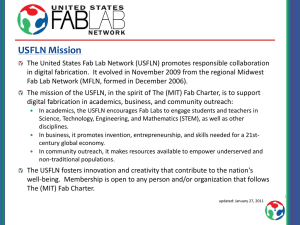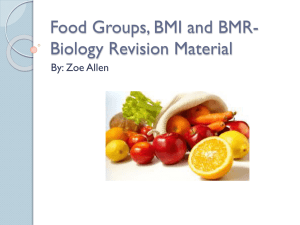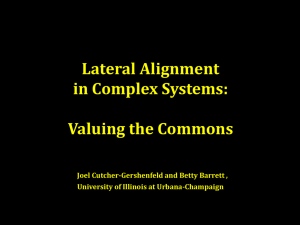
Clinical Weight Management
Guidelines of New Zealand
Communicating the Key Messages to Frontline
Healthcare Workers
Weight Management for Adults,
Children and Young People o
ple
Sharlaine Chee-Keil
Rebecca Ruwhiu-Collins
Nigel Chee
Acknowledgement:
Dr Hayden McRobbie
MB ChB (Otago) PhD (London)
Inspiring Limited
Faculty of Health and Environmental Sciences, Auckland University of Technology
Wolfson Institute of Preventive Medicine, Queen Mary University of London
1
Implementation of the
Clinical Weight Management Guidelines of New Zealand
Training outcomes
• To communicate the key messages
of the Guidelines for weight
management (national consistency)
• To apply a brief intervention
process to give advice based on
current evidence
• Ability to identify the treatment
options available based on the
evidence and when they are
appropriate
© Inspiring Limited 2011. All rights reserved.
2
Ministry of Health
The aim of the Guidelines is to provide
evidence-based guidance for weight
management. The Guidelines can be used
in primary care and community-based
initiatives
•
Ministry of Health, Clinical Trials Research Unit.
2009. Clinical Guidelines for Weight
Management in New Zealand Adults. Wellington:
Ministry of Health
•
Ministry of Health, Clinical Trials Research Unit.
2009. Clinical Guidelines for Weight
Management in New Zealand Children and
Young People. Wellington: Ministry of Health
3
Our weight problem
4
Our weight problem
• A significant number of New Zealanders are
overweight or obese
• What percentage of New Zealand adults are
obese?
5
Our weight problem
• 25% of all adults in New Zealand are classified as
obese, and many more are overweight
• 43% of Maori adults in New Zealand are obese
• 65% of Pacific Island adults in New Zealand are
obese
• South Asian population groups in New Zealand are
also more likely to be overweight or obese.
© Inspiring Limited 2011. All rights reserved.
6
Our weight problem
• What percentage of children in New
Zealand are obese?
8% of children in
New Zealand are obese
7
What does this mean for
New Zealand?
• There are significant health risks associated with being overweight
or obese such as:
– increased risk of CVD
– Type 2 diabetes
– some cancers
– asthma
– sleep apnoea
– impaired fertility
– musculoskeletal problems
• Other consequences include a reduced quality of life, a reduced
capacity for healthy social interaction and the feeling of isolation due
to social stigma
• Most recent health impact estimates found high BMI accounted for
approximately 3200 deaths (1997).
8
Benefits of effective
weight management
9
Why we need to act now
Benefits of effective weight management for
children and adults
Activity
10
Why we need to act now
• What are the benefits of effective weight
management for children and adults?
Adults
Children
Reduced risk and delay of
the onset of Type 2
diabetes
Reduced risk of obesityrelated illness in adulthood
A reduction in blood
pressure, blood glucose
and LDL cholesterol
Greater liveliness and
healthier lifestyle from a
young age
Reduction in chances of
passing weight problems
onto children and family
Stronger development of
social skills from a young
age
Reduced risk of early
mortality
Breaking the cycle of poor
weight management in
New Zealanders
11
What does the evidence tell us
The Four-step process
12
The Guidelines
Algorithms
Note: Printable Algorithm’s in QRC in the
FAB E-Learning Tool
13
14
STEP 1
Engage
and raise
awareness
15
Checkpoint:
How to approach weight
management
Which of the following patients should you be engaging in a
discussion about weight and raising awareness with? Choose the
best answer.
A.Maori, Pacific, and South Asian patients (consumers)
B.Those patients (consumers) that come in wanting to address their
weight.
C.Those patients (consumers) who are visibly overweight.
D.All patients (consumers).
16
Step 1: Engage and raise awareness
Starting the conversation
• Step 1 is to engage and raise awareness. For
many healthcare workers starting the
conversation about weight can be the hardest
step.
Activity
What are some examples of how you would
approach starting the conversation?
• Adults
• Children
17
Step 1: Engage and raise awareness
Measurement
Body mass index (BMI) provides
a good indirect measure of the fat
tissue (or adiposity) in an
individual. Use BMI to classify
overweight and obesity as part of
routine clinical practice
Waist circumference provides
additional information, especially if
excess intra-abdominal fat.
18
Body Mass Index
BMI Categories
BMI =
Normal weight: 18.5 – 24.9 kg/m2
Weight (kg)
__________
Overweight: 25 – 29.9 kg/m2
Height (m2)
Obese: More that 30 kg/m2
Note: BMI Calculator in the FAB E-Learning Tool
19
Step 1: Engage and raise awareness
BMI Measurement
BMI is an indicator of risk. It does not:
distinguish between fat and lean mass
account for ethnic differences (people with similar BMIs
of different ethnicities may have different levels of fat
tissues)
measure actual body fat or provide information about
distribution of body fat
account for people with smaller stature and with a
BMI < 25, but with a large waist (indicating abdominal
fatness)
20
Step 1: Engage and raise awareness
Waist Measurement
A waist circumference of more than 94cm in men
and 80 cm in women may indicate increased health
risks due to weight
Measure waist
circumference at the mid
point between the lowest rib
and iliac crest
21
Step 1: Engage and raise awareness
Other Measurements
Examples could include
recording clothing size
Measurements can act
as motivators once a
person starts losing
weight.
22
STEP 2
Identify
need and
context for
action
23
Step 2: Identify need and context for action
Identify the need and
motivation for action
Step 2 is to motivate clients to start a
change in their behavior
Find out about their lifestyle (or affirm a
decision they have already made to make a
change)
Give brief advice, encouragement and
allow the person to choose how to act.
24
Step 2: Identify need and context for action
Personalising your advice
• Identify key motivators
• Give some brief personal advice
that aligns with what is important
to them
• People are motivated to make a
change when they:
– understand the situation they are in
– can see the benefit in changing
– feel as if change is achievable
25
Personalising advice
Frontline Healthcare Workers
•
•
•
•
•
•
Clinic Setting (GP)
Clinic Setting (nurse)
Green prescription
Fitness consultant
Dietitian
Community health
worker
• Physiotherapist
26
STEP 3
Determine
options for
action
27
Step 3: Determine options for action
What is available
• Once you have gathered facts and given brief
advice, determining an option for action differs
from case to case
• No option is a quick fix. All require long-term
commitment, and an understanding that it is
healthiest to lose weight slowly over time
• No matter what, everyone should be given
advice about FAB
28
Step 3: Determine options for action
What is available
• The FAB approach is the most effective non surgical
approach to healthy weight management. It involves
three lifestyle interventions in combination:
1 Changes to Food and diet
2 Increasing physical Activity
3 Using Behavioural strategies
to support weight loss and
maintenance.
29
Step 3: Determine options for action
What treatment options are available
Pharmacotherapy
• Weight loss medicines (anti-obesity drugs) used in
combination with FAB can lead to increased long-term
weight loss
• Only drug the Guideline recommends is Orlistat
(Xenical). Gastrointestinal side effects. Reassess at 3
months if not lost at least 5% of inial body weight
• They are an option when other methods of weight loss
have failed, and can be used in clients with a BMI of 30
or more.
30
Step 3: Determine options for action
Bariatric Surgery
Bariatric surgery is not an alternative
to a better lifestyle, but can be
considered for people with a BMI
greater than 40
Comorbidities or for those who have
other medical problems, for example
diabetes, anti-obesity medicines and
surgery can be considered at a lower
BMI of 35
Bariatric surgery is substantially more
effective than non-surgical
interventions in people with morbid
obesity.
31
Step 3: Determine options for action
FAB
• Regardless of BMI and history, the FAB trio of
lifestyle interventions is appropriate for everyone
• FAB is the most effective non-surgical and nondrug related method for long-term weight loss
• For FAB to be successful, all three interventions
must be used in combination.
32
Step 3: Determine options for action
FAB - Food
Small changes to eating habits can
make a difference
Take lifestyle, and preferences into
consideration when suggesting dietary
changes
Modification changes could include:
reducing portion size, reduce sugar
intake, food groups, read food labels
The overall aim is to reduce total
energy intake.
33
Step 3: Determine options for action
FAB - Activity
PA with diet results in an average
increased weight loss of 1.4kg at 12
months
Goal of PA (in the Guidelines) is to
increase energy expenditure and resting
metabolic rate
Increased activity in combination with food
(diet) and behavioral support will achieve
long-term weight loss
Activity should be increased in small
achievable increments (snacktivity). Target
to aim for is 60 minutes of moderateintensity activity per day
Sense of what this means - the indicators
of a brisk walk (e.g. puffing, a slight sweat).
If there is the need for
support with physical
activity exercise on
prescription
(Green Prescription) is
a good option.
34
Step 3: Determine options for action
FAB - Behaviour
Behaviour support involves strategies to
reinforce changes. The goal is to alter
habits. Encourage small sustainable
behavioral changes
Behavior change can be the difficult
intervention to implement. Can increase
weight loss by 2-8 kg at 12 months.
Social support from others
Self monitoring (food and activity diary)
Stimulus control (removing temptation, limit
exposure to high risk situations)
Contingency management (planned use of nonfood rewards)
Cognitive restructuring (realistic goals, help
change self defeating thoughts that undermine
weight-loss efforts.
35
Step 3: Determine options for action
Checkpoint
Dave has a BMI of 29. What options for action do you think
would suit Dave best?
A. Making small changes to his diet, starting with 5–10 minutes
more exercise a day, and removing temptation by packing a
lunch each day could be a good start
B. Weight loss drugs will be the best intervention for Dave
C. Weight loss drugs in conjunction with the three FAB
interventions is the best course of action for Dave
D. Discussing bariatric surgery with Dave.
36
Step 3: Determine options for action
Checkpoint
Answer
Dave has a BMI of 29. What options for action do you
think would suit Dave best?
A. Making small changes to his diet, starting with 5–10 minutes
more exercise a day, and removing temptation by packing a
lunch each day could be a good start
37
Step 3: Determine options for action
Checkpoint
Dave mentions that he saw an advert for weight loss drugs and wanted
to get some more information about them. What would be the best
advice to give Dave?
A. I don’t know anything about weight loss drugs and so cannot advise you
B. Weight loss drugs are not a quick fix for losing weight and you will still need to
make changes to your lifestyle. The first port of call I think is to have a go at
making some small changes to your diet, physical activity, and behaviours –
you might be surprised on what you can achieve
C. Yes I can get a prescription for you, its probably what you need to lose the
weight that you’re carrying
D. I would not recommend that you use Xenical as its associated with serious
side effects. You just need a bit of willpower to succeed in losing weight.
38
Step 3: Determine options for action
Checkpoint
Answer
What would be the best advice to give Dave?
B. Weight loss drugs are not a quick fix for losing weight and
you will still need to make changes to your lifestyle. The first
port of call I think is to have a go at making some small
changes to your diet, physical activity, and behaviours – you
might be surprised on what you can achieve.
39
STEP 4
Arrange
ongoing
support and
contact
40
Step 4: Arrange ongoing support and contact
Who else can help
• As a healthcare worker, you
are one part of the formula
• Reinforce lifestiyle change
through regular brief
contact (cinical,
family/whanau, community)
• Refer to other health groups
to support change
41
Step 4: Arrange ongoing support and contact
Who can help
There are many specialists,
organisations and health groups that
can help.
Refer to existing physical activity
programmes (such as Green
prescription), church groups or
marae also offer support.
Use the Finding FAB Services
directory on the MoH HIIRC website
(July 2011).
Healthcare
workers
Whanau
Your
Client
Other health
groups
42
FOUR-STEP PROCESS
Children and Young people
43
The Facts
Children and Young people
• Requires a different approach. Overweight or obese
children and young people are at greater risk of obesity in
adulthood.
• Emphasis on slowing weight gain – as opposed to weight
loss. Focus on behaviour change.
• US Centres for Disease Control and Prevention BMI for
age and sex percentile charts to assess BMI
• BMI in the 85th percentile or higher can be classified as
overweight
• BMI in the 95th percentile or higher can be classified as
obese
44
Step 2: Identify the need and motivation for action
Children and Young people
• Explain to parents/whanau
the risks in later life.
E.g. diabetes and CVD
• Modelling behaviours
support behaviour change
• Comprehensive lifestyle
approach – whanau FAB
45
Step 3: Determine some options for action
Children and Young people
• The FAB trio of interventions are most appropriate
• It’s vital to allow children to grow into their weight through
healthier eating and activity patterns. This includes at least 60
minutes of moderate-intensity to vigorous aerobic activity each
day
• Pharmaceuticals (anti-obesity drugs) are not be used in
children and young people. Exception ONLY where BMI > 95th
centile AND FAB has not controlled weight gain. If medication
is necessary use Orlistat only (under specialist supervision)
• Surgery is NOT recommended
46
Step 4: Arrange ongoing contact and support
Children and Young people
•
Maintain contact and monitor their
progress.
•
If appropriate advise parents to have
a brief conversation with teachers,
other whanau or community
members they spend time with about
encouraging lifestyle change
•
Recommend FAB options and
involve parents in taking
responsibility. This will be the key to
long-term behavior change.
47
Children and Young people
Checkpoint
How much physical activity should Dave’s children be
encouraged to do as part of the FAB intervention?
A. At least 30 minutes of moderate physical activity each day
B. At least 60 minutes of moderate-intense to vigorous physical activity
each day
C. Focus on fun, not time, and make sure they are active at least once a
week
D. At least 60 minutes of moderate to vigorous physical activity a week
48
Children and Young people
Checkpoint
Answer
How much physical activity should Dave’s children be
encouraged to do as part of the FAB intervention?
B. At least 60 minutes of moderate-intense to vigorous physical
activity each day.
49
Children and Young people
Checkpoint
What is the best way to implement behavioural change in Dave’s
children when it comes to managing their weight? Choose the
best answer.
A. Be frank with them about their problem, and let them know the
consequences of an unhealthy lifestyle
B. Talk to them one-on-one so they aren’t embarrassed
C. Involve the whole family, and focus on positive changes for the
future, rather than weight issues now
D. All of the above
50
Children and Young people
Checkpoint
Answer
What is the best way to implement behavioural change
in Dave’s children and young people when it comes to
managing their weight? Choose the best answer.
C. Involve the whole family, and focus on positive changes for
the future, rather than weight issues now.
51
New FAB tools
• FAB E-Learning tool (printable tools, RNZCGP
approaved CME points)
www.weightmanagementfab.org.nz/
Available: - July 2011
• Finding FAB Services Directory
• Weight Management Website
https://weightmanagement.hiirc.org.nz
52
Username
Forgot ten
password?
Password
Register
Con tact adm in
Remem ber
Search this site or browse using tags to find information
and resources about weight management as part of the
FAB approach (Food, Activity, and Behavioural
Support).
All Areas
Intervent ions
People and contex ts
Food
Priority
populations
Knowledg e
library
Activit y
Comorbidities
FAB tools
Behavioural
support
Age groups
Finding FAB
services
Drugs and
surgery
Set tings
Using this site
Four steps towards weight management advice
and treatment
1. Raise awareness.
2. Identify the need and context for action.
3. Determine options for action (FAB):
Food
Activity
Behavioural support.
Site resources
4. Maintain contact and support.
Enter Keywords
Whole Site
53
New FAB tools
Social Media – Twitter, Facebook
• Keep up to date with new research, events, and
tools posted on the Weight Management
website on Facebook or Twitter
'Like' the Facebook page or 'Follow' the
Twitter feed.
• Twitter: @weightmgmtnz
• Facebook: search for "Weight Management
New Zealand”
• http://www.rnzcgp.org.nz/assets/documents/Pu
blications/JPHC/March2011/JPHCGuidelinesSummaryJullMarch11.pd
f
54
THANK YOU
55





